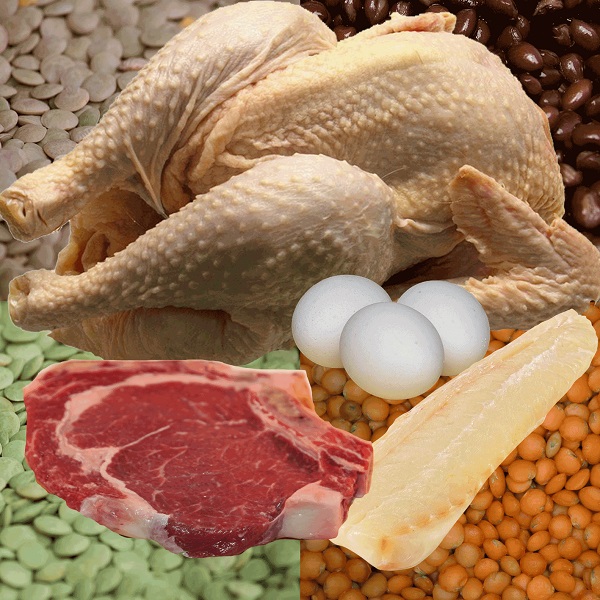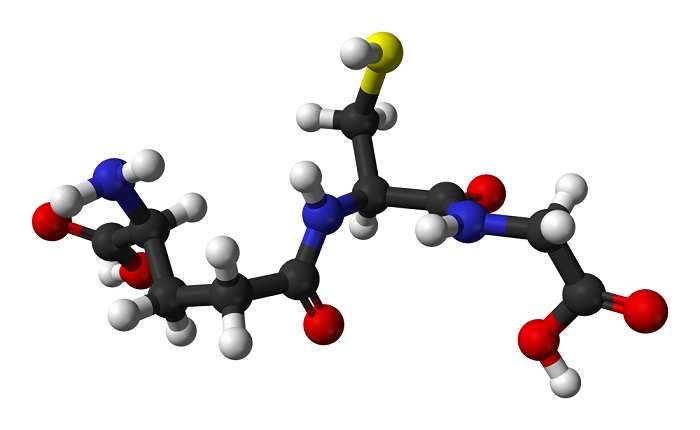Positive Health Online
Your Country

Glutathione - Super Hero of the Cell
listed in nutrition, originally published in issue 243 - January 2018
American physician and chairman of the Institute for Functional Medicine, Dr Mark Hyman says “If you haven’t heard of glutathione yet, you will. In terms of staying healthy, it’s one of the most important molecules in the body”. Chemically speaking, glutathione is a tri-peptide, made inside all body cells from the amino acids, glycine, cysteine and glutamic acid. To appreciate the power of Glutathione, an understanding is needed of the process of oxidation which damages our cells on a daily basis. It is this process which glutathione protects against.
https://en.wikipedia.org/wiki/Glutathione#/media/File:Glutathione-from-xtal-3D-balls.png
This work has been released into the public domain by its author, Benjah-bmm27. This applies worldwide. Benjah-bmm27 grants anyone the right to use this work for any purpose, without any conditions, unless such conditions are required by law.
Fighting Free Radicals
Essential body processes such as breathing, digestion, energy production, immune function, the detoxification of harmful substances including alcohol, drugs or pollution and hormonal activity, produce destructive substances known as free radicals.
The process by which these highly reactive free radicals are produced is oxidation. A good example is a freshly cut apple turning brown. Other examples of oxidation are a car rusting or a copper penny turning green. Pollution, sun exposure, stress, smoking, excessive exercise, radiation and burnt food accelerate the production of free radicals.
Chemically speaking, a free radical is a molecule with an unpaired electron which means it is unstable. Electrons are miniscule particles, invisible to the naked eye, which circulate around the nucleus of an atom, the basic unit of matter. Electrons carry an electrical charge which keeps them ‘magnetized’ to the nucleus in a cloud. However an electron will break free from the cloud if it is ‘stolen’ by a free radical from another atom with a missing electron. This results in a chain reaction which injures and destroys cells as each newly unpaired electron steals an electron from another atom, breaking chemical bonds between atoms and changing the form of molecules.
Oxygen literally burns, which is why a cut fruit such as an apple becomes brown. Squeezing antioxidant rich lemon juice onto cut apple will prevent oxidation and maintain the colour of the fruit. In a similar way, our bodies have the internal resources for the ongoing fight against free radicals, one of the principle defences being antioxidants such as glutathione. Oxidative stress occurs when there is an imbalance between free radicals and antioxidants, and is a factor in the development of many chronic illnesses and accelerated ageing.
Detoxifying Power
There is more to glutathione than its antioxidant capacity. It is also a powerful detoxifying agent and is highly concentrated in the liver as well as being found in every cell of the body. The liver is a miraculous organ with many vital functions that include the ability to detoxify harmful substances in the body. This process by which liver enzymes chemically change wastes and toxins so that they can be dissolved in water and excreted, is known as biotransformation. There are two phases of biotransformation.
In Phase One, toxic substances are combined with oxygen (oxidized) to destroy the harmful free radicals This stage produces intermediate, highly reactive toxins that can be more poisonous than the original toxins and they must be further transformed for excretion from the body. This is where glutathione comes in.
In Phase Two the toxins need to be joined together (conjugated) with another substance and converted from a fat soluble into a water soluble state so that they can leave the body through the urine or faeces. Depending on their type, the toxins are combined with different substances, via six different chemical pathways. The glutathione conjugation pathway is a major detoxification pathway.
Deficiency of Glutathione
Glutathione stores in the liver can be easily depleted. The persistent stress of modern day living and the many thousands of toxic substances in the environment, for example pesticides, pollution, plastics, household cleaners, cosmetics and pharmaceutical drugs, alcohol and chemicals in packaged foods, to name a few, will all use up supplies of glutathione, leaving the liver vulnerable to toxic damage. People with hepatitis and alcoholics have been found to have low glutathione stores.
An efficiently working liver is crucial to overall health. Conventional scientific research has shown that problems with the liver’s detoxification processes are a significant factor in chronic conditions such as ME, Alzheimer’s and Parkinson’s Disease. The conventional NHS liver test detects abnormalities in certain liver enzymes and other substances. More often than not however, such a test will show normal results unless there is more advanced damage in the liver caused by, for example infections or alcoholism. In a more subtle way, a ‘sluggish’ liver can be a factor in a multitude of symptoms ranging from allergies and respiratory problems to fatigue and depression.
As well as being concentrated in the liver, glutathione is also found in larger amounts in the lungs to deal with inhaled toxins. Asthma sufferers and people with respiratory conditions tend to be particularly low in glutathione. Dr Michael Culp, in his white paper on glutathione, references diverse clinical trials using the oral glutathione supplement, Glutacyan®, including one trial in which children with allergic asthma, showed clinical improvement in symptoms after supplementation. Deficient levels of reduced glutathione have been found in patients with arthritis, diabetes, hypertension, cardiovascular disease, lung disease, alcoholism, chronic renal failure, eye diseases, neurologic diseases, AIDS, liver disease, and cancer.
Rich Van Konynenbury PhD, an independent researcher, believed that glutathione depletion causes many of the problems in ME/CFS. Droge and Holm first suggested in 1997 that glutathione is depleted in ME/CFS and in 1998, Dr Paul Cheney reported that “nearly all his ME/CFS patients were found to be depleted in glutathione”.
Board certified nutritionist, Dr Joseph Debe says “To sum it up, deficient levels [of glutathione] have been found in 77 percent of patients with chronic illness. Adequate levels of reduced glutathione have been found to be the best biological marker of good health in older age”. He also claims “reduced glutathione chelates and removes heavy metals and many classes of toxins from the body, protects against radiation damage, influences protein and DNA synthesis, plays a role in prostaglandin and leukotriene (important hormone-like compounds) metabolism, is important for immune function, and maintains proper structure and function of proteins and enzymes, including antioxidant enzymes”.
Some further interesting research found that glutathione was effective for the prevention and treatment of fatigue and overtraining in football players. Players showing fatigue were given a supplement of 200mg reduced glutathione (Glutacyan®) with anthocyanins and responded with increased respiratory burst correlating to feeling less fatigued.
What is Reduced Glutathione?
The form in which glutathione is ingested is of vital importance. If taken by mouth, glutathione is unlikely to survive the stomach acid without being broken down into its component amino acids. Glutathione needs to be in the reduced form to be effective.
Reduced, in chemical terms, means a substance from which oxygen has been removed and electrons have been added. This means the substance is in a chemical form in which it can donate electrons. The opposite of reduced is oxidized. In an oxidized form, oxygen has been added and electrons have been lost. Oxidized glutathione will be biologically inactive. Not only that, but the oxidized glutathione will use up valuable reserves of antioxidants in the body in an attempt to reduce it.
In any given cell there will be a mixture of oxidized and reduced glutathione and the ratio between the two is known to be a good indicator of overall oxidative stress and cellular toxicity. In healthy cells and tissues 90% of the glutathione is in the reduced form.
Anthocyanins
However the story doesn’t end there. Glutathione is a very unstable molecule which can be oxidized, reduced and oxidized again. Stomach acid will oxidize reduced glutathione unless it is protected. One manufacturer claims to have solved this problem by stabilizing glutathione with a unique patented combination of plant bioflavonoids called anthocyanins. These purple/blue/black pigments are found in all plant tissue. Dark skinned fruits such as grapes, blackcurrants, cherries and berries are particularly rich sources.
Research showed that anthocyanins were able to regenerate reduced glutathione without becoming oxidized themselves. When free radicals were added to reduced glutathione and anthocyanins, initially the mixture was oxidized. However it would then spontaneously change back to the reduced form, allowing it to be delivered to cells intact and in its active form.

Glutathione in the Diet
Glutathione is made by the body from its component amino acids, glycine, glutamate and cysteine. These amino acids are found in protein foods such as fish, chicken, eggs, meat, lentils, beans and pulses. However, the body doesn’t always convert these building blocks into glutathione very efficiently. Additionally cysteine isn’t always in plentiful supply in the diet. Finally, digestive problems can lead to deficiency, despite adequate intake.
Glutathione itself is found in fish, meat, seeds and nuts. However it tends not to survive the stomach acid without being broken down. Glutathione peroxidise, an enzyme related to glutathione is found in fruit and vegetables.
This points towards the use of supplementation by certain groups of people. Thousands of Doctors in Europe already prescribe glutathione, where it has been available for more than 6 years. Glutathione is generally a very safe supplement. However, it is best taken under the guidance of a healthcare practitioner, particularly, if you are on medication or have a diagnosed medical condition.
References
Culp T. Michael. Empower Glutathione as a Novel Therapeutic Approach to Optimal Health and Wellness. 2016.
Ohlenschläger G. & Treusch G. Reduced glutathione and anthocyans -Redox cycling and redox recyclingin biological systems. Praxis Telegramm Supplement to issue No. 6/94. 1994.
Tsuda T, Horio F, Osawa T. The role of anthocyanins as an antioxidant under oxidative stress in rats. Biofactors 13(1-4):133-9. Tokaigakuen Women's College, Nagoya, Japan. 2000.
Weisel T, Baum M, Eisenbrand G, Dietrich H, Will F, Stockis JP, Kulling S, Rüfer C, Johannes C, Janzowski C.An anthocyanin/polyphenolic-rich fruit juice reduces oxidative DNA damage and increases glutathione level in healthy probands. Biotechnol J.;1(4):388-97. 2006.
Knight J., Stride M,.Webster S., Purdue J. Managing fatigue and early infection in football: a novel Approach. XXV International Conference of Sport Rehabilitation and Traumatology
Football medicine strategies-return to play. 2016.
Neuffer Dan. CFS Unravelled.
Comments:
-
No Article Comments available
